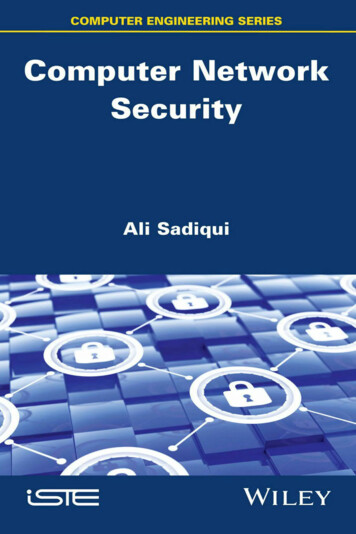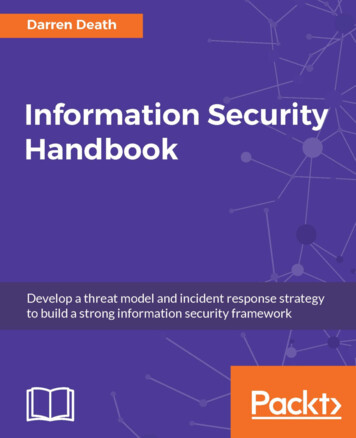
Transcription
Computer Hacking Beginners Guide
How to Hack Wireless Network, Basic Securityand Penetration Testing, Kali Linux, Your FirstHackALAN T. NORMAN
Copyright All Right Reserved.No part of this publication may be reproduced, distributed, or transmittedin any form or by any means, including photocopying, recording, or otherelectronic or mechanical methods, or by any information storage and retrievalsystem without the prior written permission of the publisher, except in thecase of very brief quotations embodied in critical reviews and certain othernoncommercial uses permitted by copyright law.Disclaimer Notice:Please not the information contained within this document is foreducational and entertainment purposes only. Every attempt has been made toprovide accurate, up to date and reliable complete information. No warrantiesof any kind are expressed or implied.By reading this document, the reader agrees that under no circumstancesare is the author responsible for any losses, direct or indirect, which areincurred as a result of the issue of information contained within thisdocument, including, but not limited to errors, omissions, or inaccuracies.
Table of ContentsWhy You Should Read This BookChapter 1. What is Hacking?Chapter 2. Vulnerabilities And ExploitsChapter 3. Getting StartedChapter 4. The Hacker’s ToolkitChapter 5. Gaining AccessChapter 6. Malicious Activity and CodeChapter 7. Wireless HackingChapter 8. Your First HackChapter 9. Defensive Security & Hacker EthicsChapter 10. Make your Own Keylogger in C Chapter 11. Setting Up The EnvironmentChapter 12. Setting the Eclipse environmentChapter 13. Programming Basics (Crash course on C )Chapter 14. A Typical ProgramChapter 15. Pointers and FilesChapter 16. Basic KeyloggerChapter 17. Upper and Lower case lettersChapter 18. Encompassing other charactersChapter 19. Hide Keylogger console windowConclusionBitcoin Whales Bonus BookOther Books by Alan T. NormanAbout The Author
Why You Should Read This BookLike any other technological advancement in human history, the benefitsgained by mankind from the computerization and digitization of our worldcome at a price. The more information we can store and transmit, the more itbecomes vulnerable to theft or destruction. The more dependent our livesbecome on technology and on rapid, instantaneous communication, thegreater are the consequences of losing access to those capabilities. It is notonly possible, but in fact routine for billions of dollars to be transferredoverseas in the blink of an eye. Entire libraries can be stored on devices nobigger than a human thumb. It is common to see toddlers playing rathermundane games on smartphones or tablets that have more computing powerthan machines which just 50 years ago would have filled entire rooms.This unprecedented concentration of data and digital wealth, coupled withsociety’s increasing reliance on digital means of storage and communication,has been a bonanza for savvy and malicious opportunists eager to takeadvantage of every vulnerability. From individuals committing petty theftand fraud, to political activists, large and highly organized criminal cabals,terrorist groups, and nation-state actors, computer hacking has become amulti-billion dollar global industry - not only in the commission of the crimesthemselves, but in the time, effort and capital dedicated to protectinginformation and resources. It is impossible to exaggerate the implications ofcomputer security in our current time. The critical infrastructure of cities andentire nations is inextricably tied to computer networks. Records of dailyfinancial transactions are digitally stored whose theft or deletion could wreakhavoc on entire economies. Sensitive email communications can swaypolitical elections or court cases when released to the public. Perhaps themost concerning of all potential vulnerabilities is in the military realm, whereincreasingly networked and computerized instruments of war must be keptout of the wrong hands at all cost. These high-profile threats are accompanied
by the lesser, but cumulative effects of smaller scale transgressions likeidentity theft and leaks of personal information that have devastatingconsequences to the lives of everyday people.Not all hackers have necessarily malicious intent. In nations withhampered freedom of speech or oppressive laws, hackers serve to spread vitalinformation among the populace that might normally be suppressed orsanitized by an authoritarian regime. Although their activity is still illegal bytheir own country’s laws, many are considered to be serving a moral purpose.Ethical lines are therefore often blurred when it comes to hacking for thepurpose of political activism or for the dissemination of information thatcould be of value to the public or to oppressed populations. In order to limitthe damage that can be done by individuals and groups with less-thanhonorable intentions, it is necessary to keep up with the tools, procedures andmindsets of hackers. Computer hackers are highly intelligent, resourceful,adaptive and extremely persistent. The best among them have always been,and will likely continue to be, a step ahead of efforts to thwart them. Thus,computer security specialists endeavor to become just as adept and practicedat the art of hacking as their criminal adversaries. In the process of gainingthis knowledge, the “ethical hacker” is expected to make a commitment notto use their acquired skills for illegal or immoral purposes.This book is intended to serve as an introduction to the language,landscape, tools, and procedures of computer hacking. As a beginner’s guide,it assumes that the reader has little prior knowledge of computer hacking perse, other than what they have been exposed to in media or casualconversation. It does assume a general layperson’s familiarity with moderncomputer terminology and the internet. Detailed instructions and specifichacking procedures are out of the scope of this book and are left for thereader to pursue further as they are more comfortable with the material.The book begins in Chapter 1: What is Hacking? with some basicdefinitions so that the reader can become familiar with some of the languageand jargon used in the realms of hacking and computer security, as well as toclear up any ambiguities in terminology. Chapter 1 also distinguishes thedifferent types of hackers with regard to their ethical and legal intentions andthe ramifications of their activities.
In Chapter 2: Vulnerabilities and Exploits, the central concept of targetvulnerability is introduced, describing the the main vulnerability categoriesand some specific examples. This leads into a discussion of how hackers takeadvantage of vulnerabilities through the practice of exploitation.Chapter 3: Getting Started walks through the many subjects and skillswith which a beginning hacker needs to become familiar. From computer andnetwork hardware, to communication protocols, to computer programminglanguages, the chief topical areas of a hacker’s knowledge base are outlined.Chapter 4: The Hacker’s Toolkit delves into the common hardware,software, operating systems, and programming languages generally preferredby hackers to ply their trade.The general procedures for some common computer attacks are surveyedin Chapter 5: Gaining Access, providing some select examples of attacks thatare often of interest to hackers and computer security professionals.Chapter 6: Malicious Activity and Code reveals some of the morenefarious attacks and constructs of hackers who aim to cause harm. Thedifferences between the different categories of malicious code are explained.Chapter 7: Wireless Hacking focuses specifically on the exploitation ofvulnerabilities in Wi-Fi network encryption protocols. The specific hardwareand software tools needed to execute simple Wi-Fi attacks are listed.The reader is given some practical guidance on setting up and practicingsome beginner-level hacking in Chapter 8: Your First Hack. Two exercisesare selected to help the aspiring hacker get their feet wet with some simpletools and inexpensive equipment.Chapter 9: Defensive Security & Hacker Ethics wraps up thisintroduction to hacking with some notes about protecting oneself fromhackers, and discusses some of the philosophical issues associated with theethics of hacking.
Chapter 1. What is Hacking?It is important to lay the groundwork for a proper introduction to computerhacking by first discussing some commonly used terms and to clear up anyambiguities with regard to their meanings. Computer professionals andserious hobbyists tend to use a lot of jargon that has evolved over the years inwhat had traditionally been a very closed and exclusive clique. It isn’t alwaysclear what certain terms mean without an understanding of the context inwhich they developed. Although by no means a complete lexicon, thischapter introduces some of the basic language used among hackers andcomputer security professionals. Other terms will appear in later chapterswithin the appropriate topics. None of these definitions are in any way“official”, but rather represent an understanding of their common usage.This chapter also attempts to clarify what hacking is as an activity, what itis not, and who hackers are. Depictions and discussions of hacking in popularculture can tend to paint an overly simplistic picture of hackers and ofhacking as a whole. Indeed, an accurate understanding is lost in thetranslation of buzzwords and popular misconceptions.Hacking & HackersThe word hacking normally conjures images of a lone cyber-criminal,hunched over a computer and transferring money at will from anunsuspecting bank, or downloading sensitive documents with ease from agovernment database. In modern English, the term hacking can take onseveral different meanings depending on the context. As a matter of generaluse, the word typically refers to the act of exploitingcomputer security vulnerabilities to gain unauthorized access to a system.However, with the emergence of cybersecurity as a major industry, computerhacking is no longer exclusively a criminal activity and is often performed by
certified professionals who have been specifically requested to assess acomputer system’s vulnerabilities (see the next section on “white hat”, “blackhat”, and “gray hat” hacking) by testing various methods of penetration.Furthermore, hacking for the purposes of national security has also become asanctioned (whether acknowledged or not) activity by many nation-states.Therefore, a broader understanding of the term should acknowledge thathacking is often authorized, even if the intruder in question is subverting thenormal process of accessing the system.Even broader use of the word hacking involves the modification,unconventional use, or subversive access of any object, process, or piece oftechnology - not just computers or networks. For instance, in the early daysof hacker subculture it was a popular activity to “hack” payphones or vendingmachines to gain access to them without the use of money - and to share theinstructions for doing so with the hacking community at large. The simple actof putting normally discarded household objects to new and innovative uses(using empty soda cans as pencil holders, etc.) is often referred to as hacking.Even certain useful processes and shortcuts for everyday life, like using to-dolists or finding creative ways to save money on products and services, areoften referred to as hacking (often called “life hacking”). It is also common toencounter the term “hacker” in reference to anyone who is especially talentedor knowledgeable in the use of computers.This book will concentrate on the concept of hacking that is specificallyconcerned with the activity of gaining access to software, computer systems,or networks through unintended means. This includes the simplest forms ofsocial engineering used to determine passwords up to the use of sophisticatedhardware and software for advanced penetration. The term hacker will thusbe used to refer to any individual, authorized or otherwise, who is attemptingto surreptitiously access a computer system or network, without regard totheir ethical intentions. The term cracker is also commonly used in place ofhacker – specifically in reference to those who are attempting to breakpasswords, bypass software restrictions, or otherwise circumvent computersecurity.The “Hats” of HackingClassic Hollywood scenes of the Old American West often featured
cartoonish depictions of gun slinging adversaries – usually a sheriff ormarshal against a dastardly bandit or a band of miscreants. It was common todistinguish the “good guys” from the “bad guys” by the color of their cowboyhats. The brave and pure protagonist usually wore a white hat, where thevillain wore a dark colored or black one. This imagery carried over into otheraspects of culture over the years and eventually made its way into the jargonof computer security.Black HatA black hat hacker (or cracker) is one who is unambiguously attemptingto subvert the security of a computer system (or closed-source software code)or information networkknowingly against the will of its owner. The goal of the black hat hackeris to gain unauthorized access to the system, either to obtain or destroyinformation, cause a disruption in operation, deny access to legitimate users,or to seize control of the system for their own purposes. Some hackers willseize, or threaten to seize, control of a system – or prevent access by others and blackmail the owner into paying a ransom before relinquishing control. Ahacker is considered a black hat even if they have what they themselveswould describe as noble intentions. In other words, even hackers who arehacking for social or political purposes are black hats because they intend toexploit any vulnerabilities they discover. Similarly, entities from adversarialnation-states that are hacking for the purposes of warfare can be consideredblack hats regardless of their justifications or the international status of theirnation.White HatBecause there are so many creative and unanticipated ways to accesscomputers and networks, often the only way to discover exploitableweaknesses is to attempt to hack one’s own system before someone withmalicious intentions does so first and causes irreparable damage. A white hathacker has been specifically authorized by the owner or custodian of a targetsystem to discover and test its vulnerabilities. This is known as penetrationtesting. The white hat hacker uses the same tools and procedures as a blackhat hacker, and often has equal knowledge and skills. In fact, it is notuncommon for a former black hat to find legitimate employment as a white
hat because black hats typically have a great deal of practical experience withsystem penetration. Government agencies and corporations have been knownto employ formerly prosecuted computer criminals to test vital systems.Gray HatAs the name implies, the term gray hat (often spelled as “grey”) is a bitless concrete in its characterization of the hacker’s ethics. A gray hat hackerdoes not necessarily have the permission of a system owner or custodian, andtherefore could be considered to be acting unethically when attempting todetect security vulnerabilities. However, a gray hat is not performing theseactions with the intention of exploiting the vulnerabilities or helping others todo so. Rather, they are essentially conducting unauthorized penetrationtesting with the goal of alerting the owner to any potential flaws. Often, grayhats will hack for the express purpose of strengthening a system that they useor enjoy to prevent any future subversion by actors with more maliciousintent.Consequences of HackingThe consequences of unauthorized computer access range from the minorcosts and inconveniences of everyday information security to severelydangerous and even deadly situations. Although there can be serious criminalpenalties against hackers who are caught and prosecuted, society at largebears the brunt of the financial and human costs of malicious hacking.Because of the interconnected nature of the modern world, a single cleverindividual sitting in a café with a laptop computer can cause enormousdamage to life and property. It is important to understand the ramifications ofhacking in order to know where to focus efforts for the prevention of certaincomputer related crimes.CriminalityThere are, of course, legal consequences for hackers caught intruding intoa computer system or network. Specific laws and penalties vary amongnations as well as among individual states and municipalities. Enforcement oflaws also varies among nations. Some governments simply do not prioritizethe prosecution of cybercrimes, especially when the victims are outside oftheir own country. This allows many hackers to operate with impunity incertain parts of the world. In fact, some advanced nations have elements
within their governments in which hacking is a prescribed function. Somemilitary and civilian security and law enforcement agencies feature divisionswhose mandate is to hack the sensitive systems of foreign adversaries. It is apoint of contention when some of these agencies intrude into the private filesand communications of their own citizens, often leading to politicalconsequences.Penalties for illegal hacking largely depend on the nature of thetransgression itself. Accessing someone’s private information without theirauthorization would likely carry a lesser penalty than using the access to stealmoney, sabotage equipment, or to commit treason. High-profile prosecutionshave resulted from hackers stealing and either selling or disseminatingpersonal, sensitive, or classified information.VictimsVictims of hacking range from being the recipients of relatively harmlesspractical jokes on social media, to those publicly embarrassed by the releaseof personal photos or emails, to victims of theft, destructive viruses, andblackmail. In more serious cases of hacking where national security isthreatened by the release of sensitive information or the destruction of criticalinfrastructure, society as a whole is the victim.Identity theft is one of the most common computer crimes. Hackers targetthe personal information of unsuspecting individuals and either use the datafor personal gain or sell it to others. Victims often don’t know that theirinformation has been compromised until they see unauthorized activity ontheir credit card or banking accounts. Although personal data is oftenobtained by hackers by targeting individual victims, some sophisticatedcriminals have in recent years been able to gain access to large databases ofpersonal and financial information by hacking the servers of retailers andonline service providers with millions of customer accounts. These highprofile data breaches have enormous cost in monetary terms, but also damagethe reputations of the targeted companies and shake the public's trust ininformation security. Similar data breaches have resulted in the publicdistribution of personal emails and photographs, often causingembarrassment, damaging relationships, and resulting is loss of employmentof the victims.
Prevention CostsThere is a classic “Catch-22“ when it comes to the prevention of hacking.For most individuals, it takes little more than some common sense, vigilance,good security practices, and some freely available software to stay protectedfrom most attacks. However, with the rise in popularity of cloud computing,where files are stored on an external server in addition to or instead of onpersonal devices, individuals have less control over the security of their owndata. Thisputs a large financial burden on the custodians of cloud servers to protectan increasingly high volume of centralized personal information.Large corporations and government entities thus regularly findthemselves spending equal or more money per year on computer securitythan they might lose in most common attacks. Nevertheless, these measuresare necessary because a successful, large-scale, sophisticated attack –however unlikely – can have catastrophic consequences. Similarly,individuals wishing to protect themselves from cyber criminals will purchasesecurity software or identity theft protection services. These costs, along withthe time and effort spent practicing good information security, can be anunwelcome burden.National and Global SecurityThe increasing reliance of industrial control systems on networkedcomputers and devices, along with the rapidly interconnected nature ofcritical infrastructure, have left the vital services of industrial nations highlyvulnerable to cyber-attack. Municipal power, water, sewer, internet, andtelevision services can be disrupted by saboteurs, whether for the purpose ofpolitical activism, blackmail, or terrorism. Even short-term interruption ofsome of these services can result in loss of life or property. The safety ofnuclear power plants is of particular concern, as we have seen in recent yearsthat hackers can implant viruses in commonly used electronic components todisrupt industrial machinery.Banking systems and financial trading networks are high value targets forhackers, whether they are seeking financial gain or to cause economic turmoilin a rival nation. Some governments are already openly deploying their own
hackers for electronic warfare. Targets for government and military hackingalso include the increasingly networked vehicles and instruments of war.Electronic components can be compromised by hackers on the productionline before they ever even make it into a tank, battleship, fighter jet, aerialdrone, or other military vehicle – so governments must be careful about whothey contract in the supply line. Sensitive email, telephone, or satellitecommunications must also be protected from adversaries. It is not just nationstates who are a threat to advanced military systems. Terrorist organizationsare becoming increasingly sophisticated and are shifting to moretechnological methods.
Chapter 2. Vulnerabilities And ExploitsThe essence of hacking is the exploitation of flaws in the security of acomputer, device, software component, or network. These flaws are knownas vulnerabilities. The goal of the hacker is to discover the vulnerabilities in asystem that will give them the easiest access or control that serves theirpurposes. Once the vulnerabilities are understood, exploitation of thosevulnerabilities can begin, whereby the hacker takes advantage of the systemflaws to gain access. Generally, black hat and white hat hackers intend toexploit the vulnerabilities, albeit for different purposes, where gray hats willattempt to notify the owner so that action can be taken to protect the system.VulnerabilitiesVulnerabilities in computing and network systems always have andalways will exist. No system can be made 100% airtight because someonewill always need to be able to access the information or services beingprotected. Moreover, the presence of human users represents a vulnerabilityin and of itself because people are notoriously poor at practicing goodsecurity. As vulnerabilities are discovered and corrected, new ones almostinstantly take their place. The back-and-forth between hacker exploitationand the implementation of security measures represents a veritable arms race,with each side becoming more sophisticated in tandem.Human VulnerabilitiesOne seldom-discussed vulnerability is that of the human user. Most usersof computers and information systems are not computer experts orcybersecurity professionals. The majority of users know very little aboutwhat goes on between their points of interface and the data or services theyare accessing. It is difficult to get people on a large scale to change theirhabits and to use recommended practices for setting passwords, carefullyvetting emails, avoiding malicious websites, and keeping their software up to
date. Businesses and government agencies spend a great deal of time andresources training employees to follow proper information securityprocedures, but it only takes one weak link in the chain to give hackers thewindow they are looking for to access an entire system or network.The most sophisticated and expensive firewalls and network intrusionprevention of systems are rendered useless when a single internal user clickson a malicious link, opens a virus in an email attachment, plugs in acompromised flash drive, or simply gives away their access password overthe phone or email. Even when repeatedly reminded of best securitypractices, common users are the easiest and most consistent vulnerability todiscover and exploit. Sometimes human vulnerabilities are as simple aspracticing bad password security by leaving passwords written on notes inplain site, sometimes even attached to hardware being used. Using easilyguessed passwords is another common user mistake. One particular corporatesystem was compromised when a clever hacker intentionally left a USB flashdrive in a company’s parking lot. When an unsuspecting employee found it,they put the drive into their work computer and subsequently unleashed avirus. Most individuals don’t take computer security seriously until anincident occurs, and even then, they often fall back into the same habits.Hackers know this and take advantage of it as often as possible.Software VulnerabilitiesAll computers rely on software (or “firmware”, in some devices) totranslate input or user commands into action. Software manages user logins,performs database queries, executes website form submissions, controlshardware and peripherals, and manages other aspects of computer andnetwork functionality that could be exploited by a hacker. Aside from the factthat programmers make mistakes and oversights, it is impossible for softwaredevelopers to anticipate every feasible vulnerability in their code. The mostdevelopers can hope for is to patch and amend their softwareas vulnerabilities are discovered. This is why it is so important to keepsoftware up to date.Some software vulnerabilities are due to errors in programming, but mostare simply due to unanticipated flaws in design. Software is often secure
when used as designed, but unforeseen and unintended combinations ofinputs, commands, and conditions often result in unanticipated consequences.Without strict controls on how users interact with software, many softwarevulnerabilities are discovered by mistake or at random. Hackers make it theirbusiness to discover these anomalies as quickly as possible.ExploitsFinding and exploiting vulnerabilities to gain access to systems is both anart and a science. Because of the dynamic nature of information security,there is a constant game of “cat and mouse” going on between hackers andsecurity professionals, and even between nation-state adversaries. In order tostay ahead (or to at least not get left too far behind), one must not only stayapprised of the latest technology and vulnerabilities, but must also be able toanticipate how both hackers and security personnel will react to changes inthe overall landscape.AccessThe most common goal of exploitation is to gain access to, and somelevel of control of, a target system. Since many systems have multiple levelsof access for the purposes of security, it is often the case that each level ofaccess has its own slate of vulnerabilities and are typically more difficult tohack as more vital functionalities are available. The ultimate access coup fora hacker is to reach the superuser or root (a UNIX term) level - known as“getting root” in hacker lingo. This highest level affords the user control ofall systems, files, databases, and settings in a given self-contained system.It can be quite difficult to breach the root level of a secure computersystem in a single exploit. More often, hackers will exploit easiervulnerabilities or take advantage of less experienced users to first gain lowlevel access. From that point, further methods can be employed to reachhigher levels from administrators up to root. With root access, a hacker canview, download, and overwrite information at will, and in some cases removeany traces that they were even in the system. For this reason, getting root in atarget system is a point of pride as the utmost achievement among both blackhat and white hat hackers.Denying Access
In many cases, gaining access to a particular target system is impossible,exceedingly difficult, or not even desired by a hacker. At times, the goal of ahacker is simply to prevent legitimate users from accessing a website ornetwork. This type of activity is known as denial-of-service (DoS). Thepurpose of conducting a DoS attack can vary. Since it is relatively simple toexecute, it is often a beginner exercise for an inexperienced hacker(“newbie”, “n00b”, or “neophyte”) in the parlance) to earn some braggingrights. More experienced hackers can execute sustained DoS attacks thatdisrupt commercial or government servers for an extended period of time.Thus, organized groups of hackers often hold a website “hostage” anddemand a ransom from the owners in exchange for halting the attack, allwithout ever having to gain access.
Chapter 3. Getting StartedHackershave a reputation for being highly intelligent individuals andprodigious in many ways. It can therefore seem to be an overwhelming anduphill task to start from scratch and reach any level of practical proficiency.One must remember that everyone must start somewhere when learning asubject or skill. With dedication and perseverance, it is possible to go as farin the world of hacking as your will can take you. One thing that will help inthe process of becoming a hacker is to set some goals. Ask yourself why youwant to learn hacking and what you intend to accomplish. Some just want tolearn the basics so they can understand how to protect themselves, theirfamily, or their busines
Anarcho-Copy










